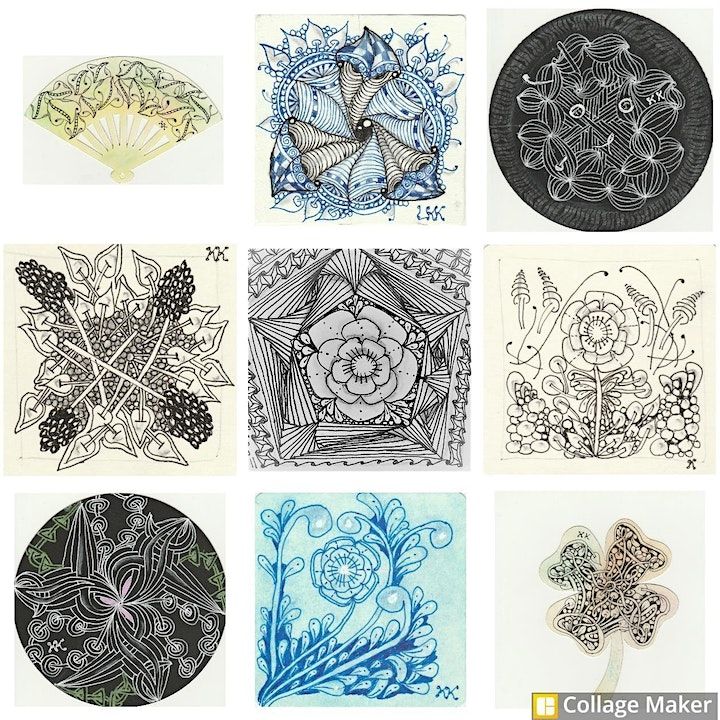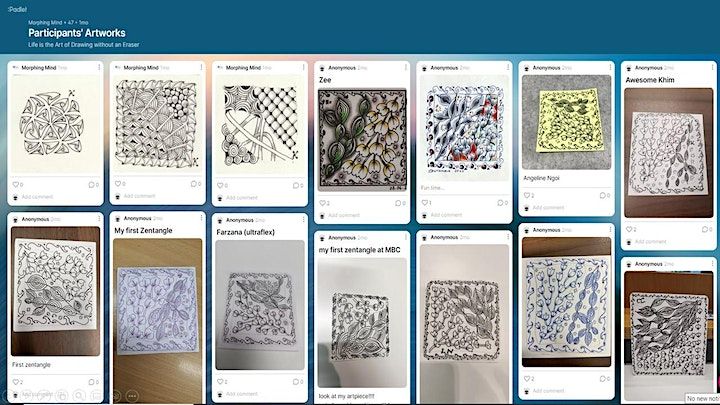Zentangle : Mindful Art Therapeutic Practice Session
Schedule
Sat Aug 27 2022 at 10:15 am to 11:15 am
Location
Online | Online, 0

About this Event
Introduction to The Zentangle Method
The Zentangle method reinforces the mental health benefits of practicing visual art with the mindfulness component
In the Zentangle method, learners follow the “8 Basic Steps” to tangle previously deconstructed pattern under the guidance of a Certified Teacher to create beautiful, structured patterns. In the Zentangle method, "Anything is possible, One stroke at a timeTM
Benefits of Applying the Zentangle Method
There are numerous research papers on the effect of the Zentangle method. The studies cover different age groups and these studies concluded that someone doing the Zentangle method of art would achieve similar mental effects as doing mindfulness practice. Here are a few of the studies:
1. Zentangle Reduces Anxiety
2. Zentangle Provides Educational Benefits
3. Zentangle Can Be Used As An Art Therapy Tool
4. Zentangle Improves Overall Well-Being
5. Zentangle Reduces Stress
6. Zentangle Enhances Creativity, Improves Motivation and Reduces Stress and Calms the Minds of Lower Grade Elementary Students
Besides researches on Zentangle, University of Arizona College of Medicine-Phoenix included art in the curriculum to help medical students sharpen their skills in observation and description, foster critical thinking, and improve communication skills.
The Art of Meditative Pattern Drawing (Zentangle) was introduced to incoming medical students at the New Student Orientation held in Payson, AZ on July 8th, 2019.
More Info : Research on The Zentangle Method
What is the Zentangle Method?
Visual art comes in many forms and medium. Some are harder to learn for beginners and some require a lot of investments in the tools, space and time.
The Zentangle method was created in 2003 by Rick Roberts, who used to practice meditation (the Zen) as a monk and Maria Thomas, who is a calligrapher (the Tangle). Hence, the Zentangle method reinforces the mental health benefits of practicing visual art with the mindfulness component.
They created the Zentangle Method for people who wanted to create art, but either believed (or had been told) that they were not artists, or they had just given up trying to be creative one way or another. With that in mind, they decided that they needed to create an art form that would be easy, fun and relaxing to learn and do.
Today, The Zentangle method has been spread around the world with several thousand Certified Zentangle Teachers around the world.
In the Zentangle method, learners follow the “8 Basic Steps” to tangle previously deconstructed pattern under the guidance of a Certified Teacher to create beautiful, structured patterns. In the Zentangle method, "Anything is possible, One stroke at a timeTM."
A beginner learning the Zentangle method needs just 4 items to start tangling. These comprise a 9 cm by 9 cm white tile (it is actually a piece of thick white paper), a Pigma pen or equivalent, a pencil and a tortillon. These items are inexpensive and very portable. A single tile can be completed in less than half an hour for an experienced tangler.
While waiting for meal to be served in a restaurant, one could tangle a tile Instead of spending time on the mobile phone. The tiles are deliberately kept small for flexibility in rotating the tiles, for portability and for the artist to be able to complete it in a short time.
The Zentangle method is easy to learn and is suitable for anyone with or without art background. Many new learners were surprised at how fast they were able to produce beautiful art works of their own after attended just one lesson from a Certified Zentangle Teacher (CZT).
Research Findings
There are numerous research papers on the effect of the Zentangle method. The studies cover different age groups and these studies concluded that someone doing the Zentangle method of art would achieve similar mental effects as doing mindfulness practice. Here are a few of the studies:
Zentangle Reduces Anxiety - Somphone Schwarzer, et al.1 conducted a study to evaluate the impact on the level of anxiety of medical students’ participation in a workshop using the Zentangle Method® for a period of two hours. Results indicated that following participation in the workshop, students experienced a significant decrease in self-reported anxiety. These findings support implementation of art-based activities for medical students as a potentially helpful means to support overall wellness.
Zentangle Provides Educational Benefits - In 2017, Sandra Hesterman and Gillian McAuliffe2 conducted studies over a ten-month period in two kindergarten classrooms in Western Australia. The two case study findings showed that Zentangle supported the development of children’s fine motor skills and enriched their language experience through the accommodation of cultural and linguistic diversity. Zentangle also provided opportunities for children to demonstrate the Early Years Learning Framework for Australia outcomes.
Zentangle Can Be Used As An Art Therapy Tool - A 2016 study by Deborah A. Kopeschny3 suggested that Zentangle can be considered as a mindful practice that promotes self-awareness, insight, creative problem solving and can also positively affect emotional and physical well-being, which makes it potentially applicable as an Art Therapy tool.
Zentangle Improves Overall Well-Being - Nearer to home, in 2019, Ha Ming Hui & Aini Marina Ma’rof conducted a study4 with the aim to examine the impact of the mindful art therapy, Zentangle®, on improving the subjective well-being of first year teacher trainee students in a Malaysian public university in terms of positive affect. The most important finding in this study was that the level of subjective well-being in terms of positive affect significantly increased after participants’ experience with the mindful art therapy.
Zentangle Reduces Stress - With Covid 19, there have been more concerns on mental heath. Rachel Immel conducted a study5 on “Zentangles for Mental Health”. She conducted 4 weekly Zentangle classes via Zoom in April 2020 for a group of university students. Participants reported significantly less stress after completing the Zentangle experience. Participants also thought that Zentangle temporarily drew focus away from common stressors including the news, deadlines, fear of failure, etc. It left participants with a tangible reminder of their accomplishments.
Zentangle Enhances Creativity, Improves Motivation and Reduces Stress and Calms the Minds of Lower Grade Elementary Students - In 2020, Tung-Chung Chia, Po-Hsiang Liu and Bo-Jia Huang6 designed a 8-week Zentangle Course for the purpose of enhancing the creativity of Elementary School Students. The conclusion after eight weeks of Zentangle teaching are: (1) Zentangle courses can effectively enhance the creative thinking of children in elementary school; (2) Zentangle courses affect the performance of lower grade students' motivation; (3) Zentangle courses can reduce the stress and calm the minds of lower grade students.
University of Arizona College of Medicine included Zentangle in the Curriculum for New Students
Besides researches on Zentangle, University of Arizona College of Medicine-Phoenix included art in the curriculum to help medical students sharpen their skills in observation and description, foster critical thinking, and improve communication skills.7
The Art of Meditative Pattern Drawing (Zentangle) was introduced to incoming medical students at the New Student Orientation held in Payson, AZ on July 8th, 2019.8
Notes
1. Meditative Drawing as an Intervention to Reduce Anxiety among Medical Students. Somphone Schwarzer, Eleanore Miller, Chelsey Rountree, Narois Nehru, Tejinder Kaur, Priya Raju, Colin Michie, and Natalie Humphrey, American University of the Caribbean School of Medicine.
2. Introducing Zentangle in the Early Years. Sandra Hesterman and Gillian McAuliffe, Murdoch University.
3. The Phenomenological Experience of Zentangle® and the Implications for Art Therapy. Deborah A. Kopeschny, St. Stephen’s College, University of Alberta.
4. Improving Undergraduate Students’ Positive Affect through Mindful Art Therapy. Ha Ming Hui & Aini Marina Ma’rof , Faculty of Educational Studies, Universiti Putra Malaysia.
5. Zentangles for Mental Health Awareness. Rachel Immel 2020, Honors Project, Bowling Green State University, Ohio.
6. Design of Zentangle Courses for Enhancing the Creativity of Elementary School Students. Tung-Chung Chia, PoHsiang Liu and Bo-Jia Huang. Paper presented at the2020 2nd International Conference on Management Science and Industrial Engineering. April 2020.
7. https://artinmedicine.wixsite.com/art-in-medicine/about
8. https://artinmedicine.wixsite.com/art-in-medicine/post/art-of-meditative-pattern-drawing
Zentangle Samples at the beginner level:

Zentangle Samples at the intermediate level:

Zentangle Drawings by our Participantshttps://padlet.com/MorphingMind/participants

More Zentangle Info and Corporate Photoshttps://www.morphingmind.com/zentangle

Where is it happening?
OnlineUSD 0.00
